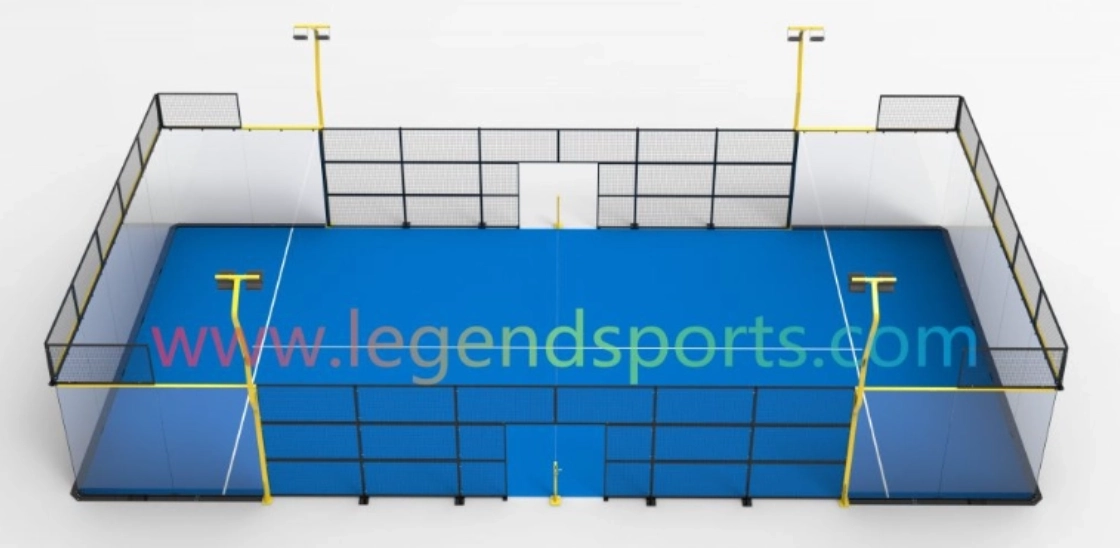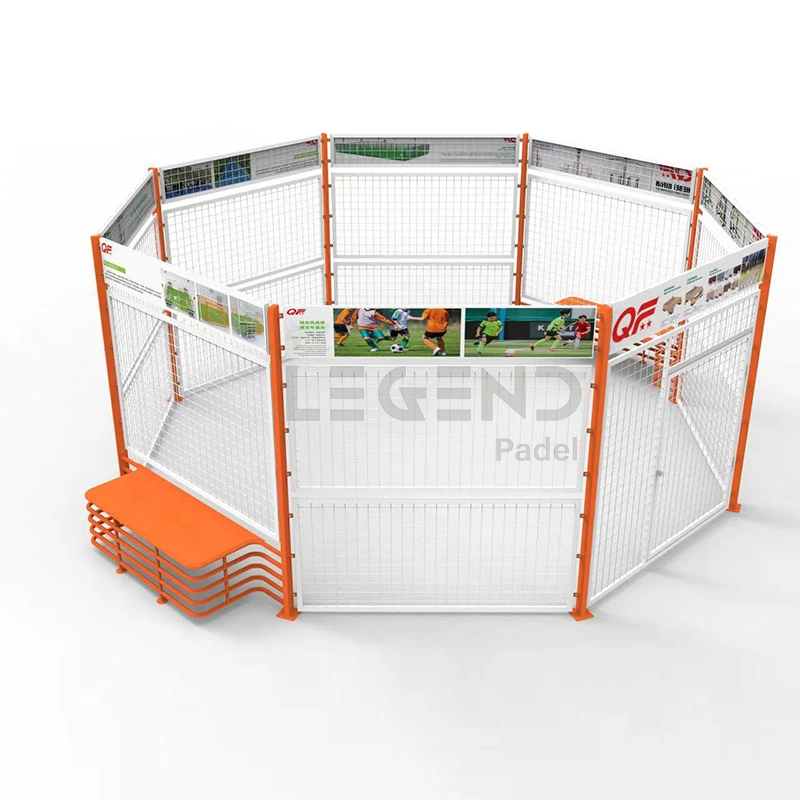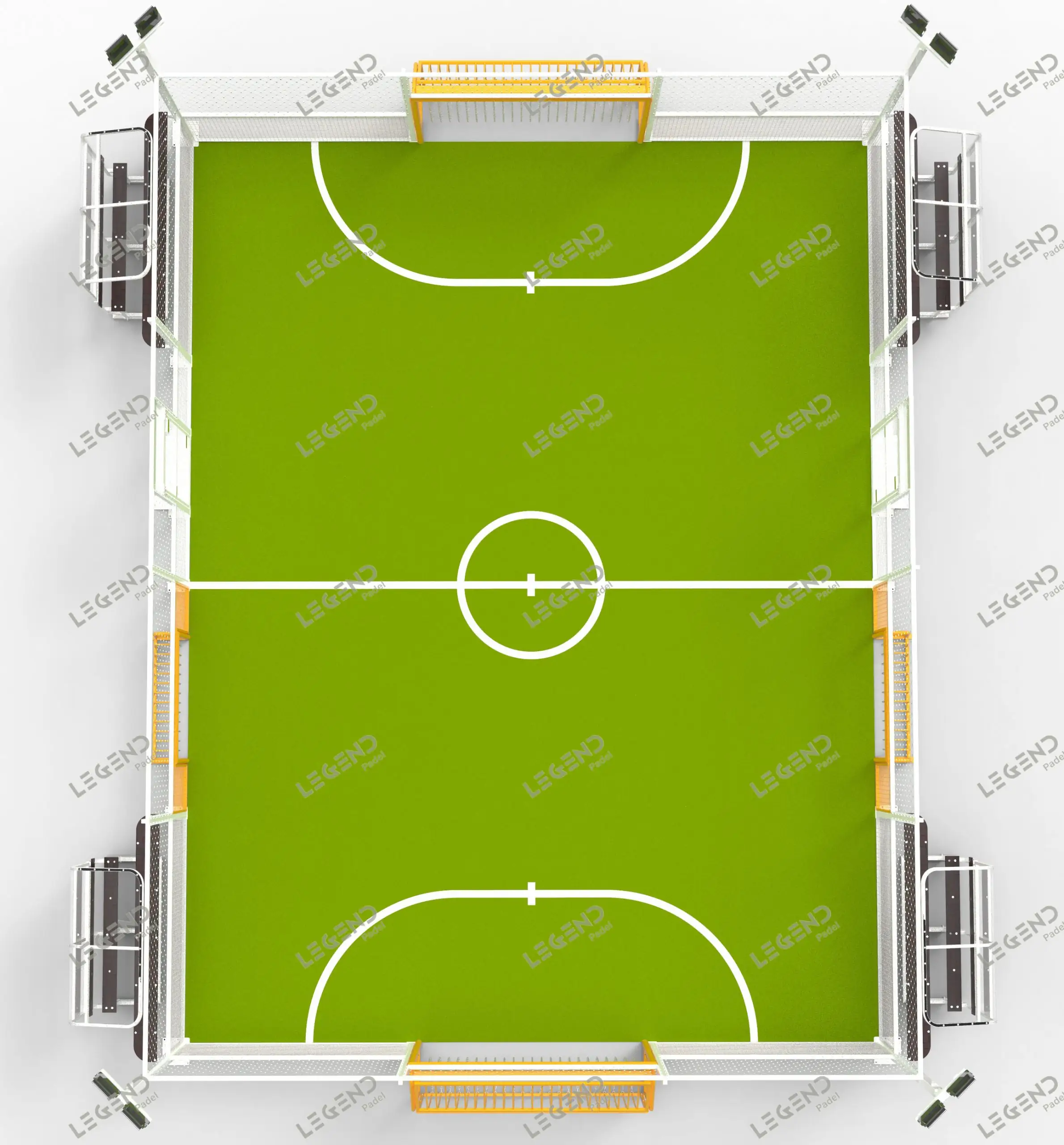Comprendre les spécifications de Padel Net
Dimensions de la réglementation
Un filet de padel a besoin de tailles spécifiques pour répondre aux règles officielles. Il doit avoir 10 mètres de long et 0,88 mètres de haut sur les côtés. Au milieu, il tombe à 0,92 mètres. Ces tailles correspondent à un standard Le Tribunal dégénéréqui est de 20 mètres de long et de 10 mètres de large pour les jeux en doubles. Les murs en verre trempé autour de la cour maintiennent les choses en sécurité et faciles à voir. Ils suivent également les normes pro.
Exigences matérielles
Les filets Padel sont fabriqués à partir de matériaux durs comme le polyéthylène ou le polyester. Ces matériaux supportent le temps extérieur et beaucoup d'utilisation. Le maillage du filet est assez petit pour empêcher les boules de passer. Mais il est assez grand pour laisser les joueurs voir à travers le terrain.
Normes de tension
L’étanchéité du filet Padel est très importante pour les bons matchs. Il devrait être serré mais pas trop étiré. Une sangle centrale maintient la bonne hauteur et la bonne tension. Cela empêche le filet de s'accrocher et assure que les balles rebondissent de la même manière à chaque fois.

Inspecter et préparer le tribunal
Vérifier les posts
Regardez les messages Web pour vous assurer qu'ils sont en bonne forme. Ils doivent être fermement fixés en place. Les poteaux sont généralement en acier fort ou en aluminium. Ceux-ci durent longtemps et gèrent bien le temps. Sports légendaires utilise l'acier SPHC avec une finition lisse et brillante pour nos cours de padel. Cela répond aux normes mondiales telles que EN12150-1.
Évaluation de l'état de surface
Avant de mettre en place, vérifiez la surface de la cour pour détecter des bosses ou des ordures. Ceux-ci peuvent gâcher les jeux ou la configuration du net. Assurez-vous que le gazon artificiel est plat et exempt de rides ou de larmes.
Rassembler les outils nécessaires
Obtenez des outils comme des clés, un ruban de mesure et des dispositifs de tension. Ceux-ci sont essentiels pour mettre en place des poteaux et s'assurer que le filet de padel est aligné correctement.
Installer le Net Posts (si pas préinstallé)
Positionner correctement les posts
Mettez les poteaux à 10 mètres de distance sur la largeur de la cour. Assurez-vous qu’ils sont alignés les uns sur les autres. Cela aide le filet de padel à s'asseoir à droite.
Sécuriser les postes en place
Fixez les poteaux dans des prises de sol ou les boulonnez directement dans le sol. Un fort ancrage les maintient stables pendant les matchs.
Réaliser un contrôle de stabilité
Après avoir réparé les postes, poussez-les pour tester s’ils sont stables. Un bon post ne bouge ni ne bouge.
Attachez le net aux postes
Processus d'attachement initial
Commencez par attacher une extrémité du filet de padel à un poteau avec des pinces ou des cravattes qui viennent avec elle. Assurez-vous que cette extrémité est serrée avant de continuer.
Étendre le réseau à travers la cour
Tirez le filet de padel sur l'autre poteau. Gardez la tension même tout le long.
Sécuriser le deuxième poste
Attachez l'autre extrémité du filet de padel au deuxième poteau avec des pinces ou des cravats. Ajustez-le pour que le filet reste même des deux côtés.
Tension le réseau
Ajuster les niveaux de tension
Utilisez un outil de tension ou ajustez à la main sur chaque poteau. Mettez le filet de padel serré mais pas trop étiré.
Vérifier la sagging dans le net
Recherchez la chute au milieu du filet de padel. L'effondrement se produit si la tension n'est pas suffisante.
Assurer une répartition uniforme de la tension
Ajustez les deux côtés de la même manière jusqu'à ce que le filet de padel soit serré partout. Cela le rend très bon pour les jeux.
Sécuriser correctement le réseau
Fixer le câble supérieur fermement
Le câble supérieur dans le filet de padel doit être serré serré dans les rainures en haut de chaque poteau.
Sécuriser les bords inférieurs et latéraux du réseau
Liez les bords inférieurs près de la pelouse, ce qui permet aux balles de rebondir en douceur pendant les matchs.
Installation et ajustement de la sangle centrale
Mettez une sangle centrale sous le milieu du filet de padel. Cela maintient la hauteur pendant les matchs difficiles.

Vérifier l'alignement et la conformité
Mesurer les hauteurs pour une précision
Obtenir la bonne hauteur du filet de padel est la clé pour les jeux équitables. Il devrait être de 0,88 mètres aux côtés et de 0,92 mètres au centre. Ces tailles suivent les règles officielles. Utilisez un ruban de mesure pour vérifier avant de faire d'autres ajustements.
Vérifier l'alignement global du réseau
Après avoir mis en place le filet de padel, assurez-vous qu’il est droit à travers la cour. Il devrait s'aligner avec les murs en verre trempé. Ces murs maintiennent la cour en sécurité et claire pour voir à travers. Legend Sports s'assure que nos tribunaux respectent les règles mondiales pour une configuration parfaite. Réparez immédiatement les pièces tordues pour éviter les problèmes de jeu.
Test de stabilité de l'installation
Testez si la configuration du filet de padel est solide. Poussez les postes pour voir s'ils bougent. Un fort ancrage arrête les problèmes pendant les matchs. Si elle est oscillante, serrez les boulons ou fixez les prises.
Effectuer des contrôles d'entretien
Inspection régulière de l'usure et de la déchirure
Vérifiez souvent le filet de padel pour détecter des dommages, tels que des bords déchirés ou une maille faible. Les filets en polyéthylène ou en polyester sont durs, mais vous devez toujours les regarder. Réparez ou remplacez rapidement les pièces cassées pour garder la cour en sécurité et bien fonctionner.
Re-Tension si nécessaire
Au fil du temps, le filet de padel peut se détacher et s'affaisser au milieu. Utilisez un outil de tension ou ajustez-le à la main pour le rendre serré à nouveau. Cela permet aux balles de rebondir à droite et suit les règles.
Nettoyage et entretien du réseau
Nettoyez le filet de padel de temps en temps pour le garder agréable. Utilisez du savon doux et de l'eau pour nettoyer la saleté. Ne pas utiliser de produits chimiques forts. Ils peuvent endommager les fibres du filet ou changer sa couleur.

Considérations de sécurité lors de l'installation
Assurer un ancrage sécurisé
Fixer les postes fermement est un grand besoin de sécurité. Les poteaux doivent être verrouillés dans les prises de sol ou boulonnés au sol stable. Legend Sports utilise l'acier SPHC pour des poteaux résistants aux intempéries.
Éviter les bords pointus ou rugueux
Vérifiez toutes les parties du système de filet de padel pour détecter des points pointus ou rugueux. Ceux-ci peuvent être dangereux pendant la mise en place ou le jeu. Lisez-les avec des outils ou remplacez les pièces mauvaises.
Améliorer la résistance aux intempéries
Choisissez des filets de padel traités pour la protection UV et la résistance à l'eau. Legend Sports utilise une double pulvérisation pour arrêter la rouille et la corrosion sur leurs pièces en acier. Cela rend l'équipement judiciaire plus durable.
Explorez l'équipement de Padel avec Legend Sports
Lancé en 2007, Legend Sports est un fabricant de premier plan dans le monde du paddle court. Avec 17 ans de savoir-faire, nous construisons des produits de haute qualité qui répondent aux règles mondiales. Nous offrons des cours classiques, des cours panoramiques, super courts panoramiquesCours mobiles et courts simples pour toutes sortes de joueurs.
Legend Sports propose des solutions personnalisées pour répondre aux besoins des clients. Cela donne aux joueurs une grande expérience dans le monde entier. Nos produits vont dans plus de 60 pays sur six continents, montrant notre rôle important dans la croissance de ce sport amusant.
FAQ (questions fréquentes)
Question : Comment installer un court de padel ?
R: La mise en place d'un court de padel prend quelques étapes. Tout d’abord, préparez le site. Ensuite, posez des murs en verre trempé. Ensuite, posez la gazonne artificielle. Après cela, fixez les structures en acier en place. Ajoutez des lumières LED. Enfin, mettre en place les postes de net et le net de padel pour respecter les règles officielles.
Question : Quelles sont les exigences pour un padel ?
R: Un court de padel standard est de 20 mètres de long et de 10 mètres de large. Il a des murs en verre trempé pour la sécurité et des vues claires. Le gazon artificiel doit être de 12mm de haut avec remplissage de sable de silice pour le meilleur jeu.
Question : Pourquoi un filet de tennis tombe-t-il au milieu ?
R: Un filet de tennis ou de padel plonge un peu au milieu en raison de sa conception. Il est plus haut sur les côtés (0,88 m) et plus bas au centre (0,92 m). Cette forme aide les balles à voler droite pendant les matchs et suit les règles officielles.





